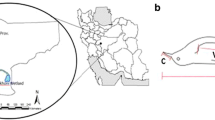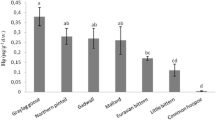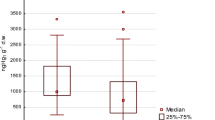Abstract
We examined mercury levels in several tissues of Common Terns and Slender-billed Gulls collected from Shadegan Marshes of south-western Iran. In both species, total mercury content was highest in feathers followed by liver, kidney and muscle tissue. We found a significant correlation between mercury concentrations in kidney and breast feather (r = 0.83, p < 0.05), breast feather and liver (r = 0.81, p < 0.05) as well as liver and kidney (r = 0.83, p < 0.05). The contaminant levels in the feathers (11.53 and 15.32 μg/g in breast feather and tail feather, respectively) of Common Terns from Shadegan Marshes are higher than those reported for other tern species from elsewhere in the world, but feather mercury of Slender-billed Gull (6.61 and 5.35 μg/g in breast feather and tail feather, respectively) was similar to those reported for gull species worldwide. Mean values for mercury in the feather of two seabird species were higher than the levels known to cause adverse effects.




Similar content being viewed by others
References
Thompson DR, Furness R (1989) The chemical form of mercury stored in South Atlantic seabirds. Environ Pollut Ser A 60:305–317. doi:10.1016/0269-7491(89)90111-5
Monteiro LR, Granadeiro JP, Furness RW, Oliveira P (1999) Contemporary patterns of mercury contamination in the Portuguese Atlantic inferred from mercury concentrations in seabird tissues. Mar Environ Res 47:137–156. doi:10.1016/S0141-1136(98)00110-X
Bearhop S, Waldron S, Thompson D, Furness R (2000) Bioamplification of mercury in Great Skua Catharacta skua chicks: the influence of trophic status as determined by stable isotope signatures of blood and feathers. Mar Pollut Bull 40:181–185. doi:10.1016/S0025-326X(99)00205-2
Burger J, Gochfeld M (2004) Marine birds as sentinels of environmental pollution. Eco Health 1:263–274. doi:10.1007/s10393-004-0096-4
Inger R, Bearhop S (2008) Applications of stable isotope analyses to avian ecology. Ibis 150:447–461. doi:10.1111/j.1474-919x.2008.00839.x
Evans MI (1994) Important bird areas in the Middle East. Bird Life International, Cambridge
Zamani-Ahmadmahmoodi R, Esmaili-Sari A, Gasempouri SM, Savabieasfahani M (2009) Mercury levels in selected tissues of three kingfisher species; Ceryle rudis, Alcedo atthis, and Halcyon smyrnensi, from Shadegan Marshes of Iran. Ecotoxicology 18:319–324. doi:10.1007/s10646-008-0284-z
Tsipoura N, Burger J, Feltes R, Yacabucci J, Mizrahi D, Jeitner C, Gochfeld M (2008) Metal concentrations in three species of passerine birds breeding in the Hackensack Meadowlands of New Jersey. Environ Res 107:218–228. doi:10.1016/j.envres.2007.11.003
Al-Majid NB, Preston MR (2000) Factors influencing the total mercury and methyl mercury in the hair of the fishermen of Kuwait. Environ Pollut 109:239–250. doi:10.1016/S0269-7491(99)00261-4
Goede AA, de Bruin M (1984) The use of bird feather parts as a monitor for metal pollution. Environ Pollut 37:287–309. doi:10.1016/0143-148X(84)90028-4
Nam DH, Anan Y, Ikemoto T, Okabe Y, Kim EY, Subramanian A, Saeki K, Tanabe S (2005) Specific accumulation of 20 trace elements in great cormorants (Phalacrocorax carbo) from Japan. Environ Pollut 134:503–514. doi:10.1016/j.envpol.2004.09.003
Braune BM, Gaskin DE (1987) A mercury budget for the Bonaparte’s gull during autumn moult. Ornis Scand 18:244–25. doi:10.2307/3676891
Braune BM, Gaskin DE (1987) Mercury levels in Bonaparte’s gull (Larus philadelphia) during autumn molt in the Quoddy region, New Brunswick, Canada. Arch Environ Contam Toxicol 16:539–549. doi:10.1007/BF01055810
Lewis SA, Furness RW (1991) Mercury accumulation and excretion in laboratory reared Black-Headed Gull Larus ridibundus chicks. Arch Environ Contam Toxicol 21:316–320. doi:10.1007/BF01055352
Rothschild RFN, Duffy LK (2005) Mercury concentrations in muscle, brain and bone of Western Alaskan waterfowl. Sci Total Environ 349:277–283. doi:10.1016/j.scitotenv.2005.05.021
Swiergosz R (1998) Mercury accumulation in the muscles and feathers of pheasants, Phasianus colchicus (L. 1758). Biometals 11:139–143. doi:10.1023/A:1009282029415
Furness RW, Hutton M (1979) Pollution levels in the great skua Catharacta skua. Environ Pollut 63:261–268
Ohlendorf HM, Harrison CS (1986) Mercury, selenium, cadmium and organochlorines in eggs of three Hawaiian seabird species. Environ Pollut Ser B 11:169–191. doi:10.1016/0143-148X(86)90022-4
Furness RW, Hutton M (1980) Pollutants and impaired breeding of Great Skuas Catharacta skua in Britain. Ibis 122:88–94. doi:10.1111/j.1474-919X.1980.tb00875.x
Hutton M (1981) Accumulation of heavy metals and selenium in three seabird species from the United Kingdom. Environ Pollut Ser A 26:129–145. doi:10.1016/0143-1471(81)90043-X
Burger J, Gochfeld M (2000) Metal levels in feathers of 12 species of seabirds from Midway Atoll in the northern Pacific Ocean. Sci Total Environ 257:37–52. doi:10.1016/S0048-9697(00)00496-4
Burger J, Gochfeld M (2003) Spatial and temporal patterns in metal levels in eggs of common terns (Sterna hirundo) in New Jersey. Sci Total Environ 311:91–100. doi:10.1016/S0048-9697(03)00135-9
Burger J, Gochfeld M (1991) Lead, mercury, and cadmium in feathers of tropical terns in Puerto Rico and Australia. Arch Environ Contam Toxicol 21:311–315. doi:10.1007/BF01055351
Burger J, Seyboldt S, Morganstein N, Clark K (1993) Heavy metals and selenium in feathers of three shorebird species from Delaware Bay. Environ Monit Assess 28:189–198. doi:10.1007/BF00547037
Zolfaghari G, Esmaili-Sari A, Ghasempouri SM, Kiabi BH (2007) Examination of mercury concentration in the feather of 18 species of birds in southwest Iran. Environ Res 104(2):258–265. doi:10.1016/j.envres.2006.12.002
Zamani-Ahmadmahmoodi R, Esmaili-Sari A, Ghasempouri SM, Mansoori J, Bahramifar N (2008) Mercury level in Liver, kidney and muscle of Common Teal Anas crecca from Shadegan Marshes, southwest Iran. Podoces 3(1/2):128–131
Pekarik C, Weseloh DV (1998) Organochlorine contaminants in herring gull eggs from the Great Lakes 1974–1995: change point regression analysis and short-term regression. Environ Monit Assess 53:77–115. doi:10.1023/A:1006035706753
Acknowledgments
Special thanks are due to Morteza Davodi, Mohamad mehdi Hoseyni, Alireza Nikvarz and Majid Zaboli for their field assistance. This work is supported by Ministry of Science, Research and Technology of Iran.
Ethical Standards
Animal studies have been approved by the appropriate ethics committee and have therefore been performed in accordance with the ethical standards laid down in the 1964 Declaration of Helsinki and its later amendments. The manuscript does not contain clinical studies or patient data.
Conflict of Interest
The authors declare that they have no conflict of interest.
Author information
Authors and Affiliations
Corresponding author
Rights and permissions
About this article
Cite this article
Zamani-Ahmadmahmoodi, R., Alahverdi, M. & Mirzaei, R. Mercury Concentrations in Common Tern Sterna hirundo and Slender-billed Gull Larus genei from the Shadegan Marshes of Iran, in North-western Corner of the Persian Gulf. Biol Trace Elem Res 159, 161–166 (2014). https://doi.org/10.1007/s12011-014-0006-8
Received:
Accepted:
Published:
Issue Date:
DOI: https://doi.org/10.1007/s12011-014-0006-8




